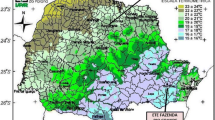Abstract
The determination of field inactivation rates of oocysts in sludge and soil is important as many land applications use sludgeas a means of fertilizing the soil. Approximately 2.5 × 105 oocysts were spiked into separate sentinel chamberscontaining a 1.0 g mixture of sludge and soil. The sentinelchambers were exposed to the soil surface environment for 60 daysat a depth of 10 cm in order to evaluate the field inactivationrates of oocysts. The mass balance approach was used to determinethe number of oocysts lost in the experiments. The results of thestudy showed that oocysts could survive environmental stress insoil. The mean inactivation rate of oocysts in the sentinelchambers at time intervals of 0 to 17 days, 17 to 30 days, 30 to45days, and 45 to 60 days were 0.0045, 0.0033, 0.0043, and 0.012day-1, respectively. Whereas, the mean inactivation rates ofoocysts in control units at time intervals of 0 to 17 days, 17 to30 days, 30 to 45 days, and 45 to 60 days were 0.0023, 0.0019,0.0017, and 0.0025 day-1, respectively. An average of 4.8percent of oocysts were lost in the experiments. Overall, thestudy demonstrated the presence of viable oocysts in sludge samples, which could potentially be used to fertilize agricultural land.
Similar content being viewed by others
References
American Society of Testing Materials.: 1997, Annual Book of ASTM Standards: Section of Construction, American Society of Testing Materials, West Conshohocken, PA, 4.09, 27–29.
APHA, AWWA, and WPCF: 1980, Standard Method for Water and Wastewater, 15th Edition, American Public Health Association, Washington, DC, Section 408E, 292–293.
Chick, H.: 1908, ‘An investigation of the laws of disinfection’, J. Hygiene 8(92), 158.
Frey, M. M., Hancock, C. D. and Logsdon, G. S.: 1997, Critical Evaluation of Cryptosporidium Research and Research Needs, AWWARF and AWWA, Denver, Colo., p 174.
Geertsema, W. S., Knocke, W. R., Novak, J. T. and Dove, D.: 1994, ‘Long-term effects of sludge application to land’, J. Amer. Water Works Assoc. 86(11), 64–74.
Heisz, M., Chauret, C., Chen, P., Springthorpe, S. and Sattar, S. A.: 1997, In vitro Survival of Cryptosporidium Oocysts in Natural Waters, Proceedings of the International Symposium on Waterborne Cryptosporidium, Newport Beach, CA, March 1997, pp 171–182.
Jenkins, M. B., Walker, M. J., Bowman, D. D., Anthony, L. C. and Chiorse, W. C.: 1999, ‘Use of a sentinel system for field measurements of Cryptosporidium parvum oocyst inactivation in soil and animal waste’, Appl. Environ. Microbiol. 65(5), 1998–2005.
Jones, K. H. and Senft, J. A.: 1985, ‘An improved method to determine cell viability by simultaneous staining with fluorescein diacetate-propidium iodide’, J. Histochem. Cytochem. 33(1), 77–79.
LeChevallier, M. W., Norton, W. D. and Lee, R. G.: 1991, ‘Giardia and Cryptosporidium in filtered drinking water supplies’, Appl. Environ. Microbiol. 57(9), 2610–2626.
Lucas, J. B., Dillaha, T. A., Reneau, R. B., Novak, J. T. and Knocke, W. R.: 1994, ‘Alum sludge land application and its effects on plant growth’, J. Amer. Water Works Assoc. 86(11), 75–83.
Mawdsley, J. L, Brook, A. E. and Merry, R. J.: 1996, ‘Movement of protozoan pathogen Cryptosporidium parvum through three contrasting soil types’, Biol. Fertil. Soils. 21, 30–36.
Miller, R. O. and Kotuby-Amacher, J.: 1997, Soil and Plant Analytical Methods, Version 4.0,Western State Laboratory Proficiency Testing Program, Soil Science Society of America, Madison,Wisc., pp 103–107.
Opflow: 1997, ‘Getting the Jump on Cryptosporidium with UV’, American Water Works Association. 23(10), 1–10.
Page, A. L., Miller, R. H. and Keeney, D. R.: 1982, Method of Soil Analysis. Part 2 Chemical and Microbiological Properties, Second Edition. American Society of Agronomy and Soil Science Society of America, Madison, Wisc. 1159 pp.
Prescott, L. M., Harley, J. P. and Klein, D. A.: 1999, Cryptosporidiosis. Microbiology, Fourth Edition McGraw-Hill, New York, Chapter 39, 822–823.
Robertson, L. J., Campbell, A. T. and Smith, H. V.: 1992, ‘Survival of oocysts of Cryptosporidium parvum under various environmental pressures’, Appl. Environ. Microbiol. 58, 3494–3500.
Robertson, J. B. and Edberg, S. C.: 1997, ‘Natural protection of spring and well drinking water against surface microbial contamination. Hydrogeology parameters’, Critic. Rev. Microbiol. 23(2), 143–178.
Rose, J. B.: 1988, ‘Occurrence and significance of Cryptosporidium in water’, J. Amer. Water Works Assoc. 80, 53–58.
Udeh, J. P., Veenstra, N. J., John, G. H.: 2000, ‘Quanitative polymerase chain reaction (QPCR) using the MIMIC approach to estimate Cryptosporidium parvum oocysts, an intestinal pathogen, in municipal water treatment sludge samples’, Mol. Cellular Probes 14(2), 121–126.
Walker, M. J., Montemagno, C. D. and Jenkins, M. B.: 1998, ‘Source water assessment and nonpoint sources of acutely toxic contaminants: a review research related to survival and transport of oocysts’, Water Res. Res. 34(12), 3383–3392.
Author information
Authors and Affiliations
Rights and permissions
About this article
Cite this article
Udeh, P.J., John, G. & Veenstra, J.N. Field Inactivation of Oocysts Exposed to Agricultural Land. Water, Air, & Soil Pollution 142, 211–228 (2003). https://doi.org/10.1023/A:1022040701478
Issue Date:
DOI: https://doi.org/10.1023/A:1022040701478




